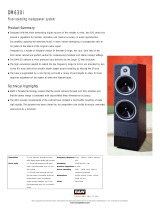
12
When connecting the Loudspeaker Hookup Cables to
the XR100 Loudspeaker Input Terminals please follow
the steps below:
1. Rotate the end of the Input Ter-
minal Post counterclockwise
until an opening appears. Refer
to gures A and B.
2. Insert the Loudspeaker hookup
cable into the Input Terminal
Post opening or the cable spade
lug around the center post of the
Input Terminal. Refer to gure
C.
3. Rotate the end of the Input Ter-
minal Post clockwise until it is
nger tight. Refer to gure D.
4. Place the supplied McIntosh
Wrench over the end of the
Input Terminal and rotate it one
quarter of a turn (90° ) to secure
the Loudspeaker Cable Connec-
tion. Do not over tighten. Refer
to gure E.
Caution: The AC Power Cord should not be connected to
the Amplifier until after the Loudspeaker Con-
nections have been made. Failure to observe
this could result in Electric Shock.
For illumination of the XR100 Loudspeaker McIntosh
Name Plate follow the steps below:
1. Connect a Power Control Cable from Power
Amplifier One, Power Control Output 1 to Power
Amplifier Two Power Control IN.
2. Connect a Power Control Cable from Power Am-
plifier Two, Power Control Output 1 to the XR100
POWER CONTROL IN.
3. Connect a second Power Control Cable from the
first XR100 Loudspeaker POWER CONTROL
OUT to the next XR100 POWER CONTROL IN.
4. Connect any additional McIntosh Loudspeakers
with illuminated McIntosh Name Plates in a simi-
lar manner, as outlined in steps 1 and 2.
Note: When the XR100 Loudspeaker System is driven
by two amplifiers, the output levels of differ-
ent model amplifiers connected to the Loud-
speaker System must be adjusted to achieve a
proper balance between the low and midrange/
high frequencies reproduced. This adjustment
is best achieved through the use of audio test
equipment operated by a qualified installer.
When connecting a XR100 Loudspeaker to an ampli-
fier it is very important to use cables of adequate size,
so there is little to no power loss in the cables. The
size is specified in Gauge Numbers or AWG (Ameri-
can Wire Gauge). The smaller the Gauge number, the
larger the wire size:
Loudspeaker Cable Distance vs Wire Gauge Guide
Loudspeaker
Impedance
25 feet
(7.62 meters)
or less
50 feet
(15.24 meters)
or less
100 feet
(30.48 meters)
or less
2 Ohms
12AWG 10AWG 8AWG
4 Ohms
14AWG 12AWG 10AWG
8 Ohms
16AWG 14AWG 12AWG
5. Prepare Loudspeaker cables by choosing one of the
methods below:
Bare wire cable ends:
Carefully remove sufficient insulation from the
cable ends, refer to figures 12, 13 & 14. If the
cable is stranded,
carefully twist the
strands together as
tightly as possible.
Notes: 1. If desired, the twisted ends can be tinned
with solder to keep the strands together.
2. The prepared bare wire cable ends may be
inserted into spade lug connectors.
3. Banana plugs are for use in the United
States and Canada only.
Banana Plugs are for use in the United States and
Canada only:
6. Remove the XR100 metal jumpers between the
Negative (-) LOW and HIGH/MID Terminals and
between the Positive (+) LOW and HIGH/MID
terminals. Retain them for possible future use.
7. Attach the previously prepared bare
wire cable ends into the banana plugs
and secure the connections. Refer to
figure F.
8. Rotate the top of the Output Terminal
Post clockwise until it is nger tight.
Refer to gure G. Then using the McIn-
tosh Wrench, rotate the top of the Output
Terminal one quarter of a turn (90° ). Do
not over tighten. Refer to gure E.
9. Referring to figure H and the illustration on the
next page, connect the Loud-
speaker hookup cables with
banana plugs into the hole at the
end of the XR100 LOW Negative
(-) and Positive (+) Input Terminals. Then connect
cables to the XR100 HIGH/MID Negative (-) and
Positive (+) Input Terminals.
Note: It is important to maintain the correct polar-
ity at both ends of the Loudspeaker cables.
10. Connect cables from the XR100 LOW Terminals
to the Left Channel Negative (-) and Positive (+)
8 Ω Output Terminals of Power Amplifier Two.
Then connect cables from the XR100 HIGH/MID
How to Connect using two Amplifiers
Figure 12
Figure 13 Figure 14
Figure A
Figure B
Figure C Figure D
Figure E
Input Terminals
Figure G



















